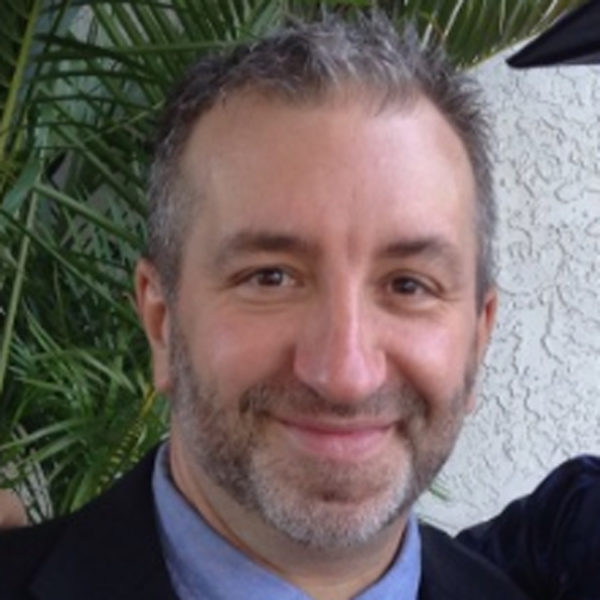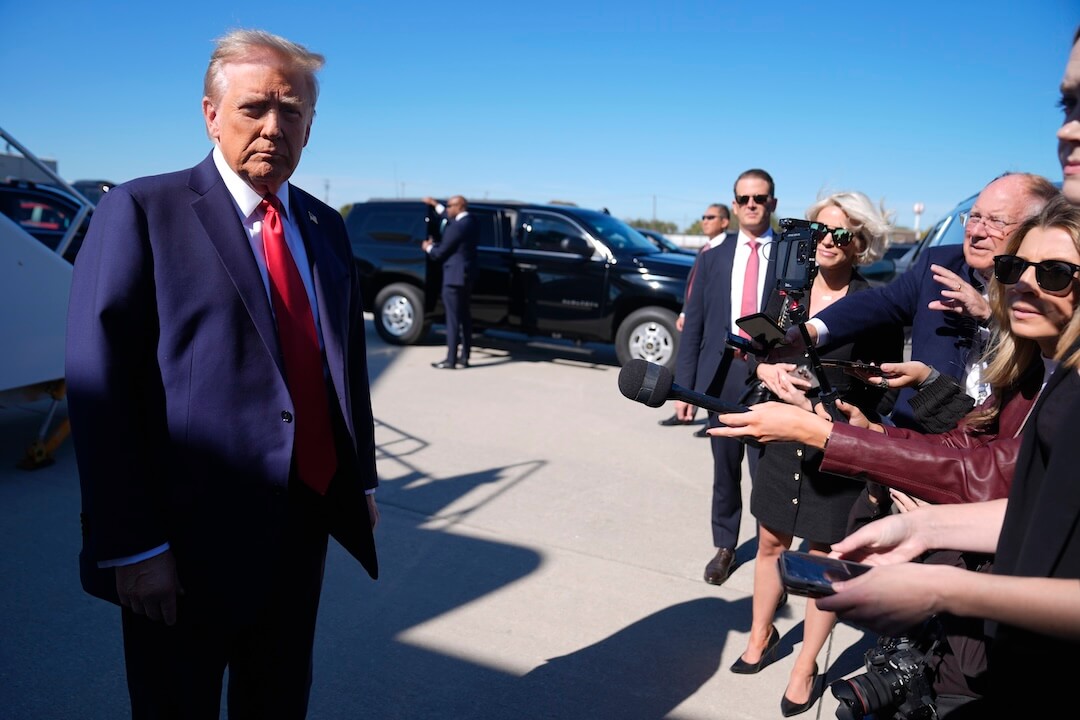This is the Poynter Institute’s daily newsletter. To have it delivered to your inbox Monday-Friday, click here.
Good Tuesday morning. We continue to try to understand what happened over the weekend. President Donald Trump addressed the nation on Monday and the debate about the shootings rages on. But let’s start with the human experience of what it’s like to be the presence of a shooter.
What it’s like to face an active shooter
Mourners visit a makeshift memorial in Dayton, Ohio. (AP Photo/John Minchillo)
Tom Fox knows what it’s like to be in the middle of a scene described by the two scariest words there are these days: active shooter. Fox is the Dallas Morning News photographer who came face-to-face with a shooter outside a Dallas courthouse in June and took a photo that went viral.
Fox hasn’t seen much of the news in the past few days from El Paso or Dayton. He has been jeeping in the San Juan Mountains of Colorado on an annual father-daughter trip.
“Some part of me is thankful for that,” Fox told me in an email. “The other part of me gets angry about this happening again and sad for the families that are having to endure such tragedy and hardship in the fallout of these incidents. For those survivors, I know first-hand how it feels to be threatened in such a violent manner and my thoughts and prayers go out to them.”
Originally on a mundane assignment on that June day, Fox found himself a mere 12 feet away from a man holding a rifle. After snapping a few photos, Fox remembers running away and not wanting to be shot in the back. He found a familiar alcove — a place where he has stood many times to get out of the sun or the rain.
“I never thought I would get into that spot to protect my life,” Fox told me several weeks after the incident. “I’m just hunkering down praying I don’t get shot. I just said, ‘Please don’t pass me. Don’t see me please.’”
The shooter never did. He was killed a few moments later before harming anyone. The whole ordeal lasted only two minutes.
“My heart was racing for like days afterward,” Fox said.
These days, Fox said the hellos and goodbyes with his 16-year-old daughter, Avery, are a little more special.
“She hugs and kisses me a little more,” Fox said. “She’s a little closer to me now. Not that we weren’t close before, but she goes out of her way to make sure that I’m doing OK.”
Fox took a week off work then was back at it — but only after seeking therapy.
“Nothing has really hit me or devastated me,” Fox said. “There haven’t been sleepless nights or anything. Every once in a while, you think about it. And you think, ‘Why is this coming to me now?’ There might be some little things over time that might creep in a little bit. So I just wanted to get ahead of that.”
But this past weekend reminded him of that day, hiding in that alcove.
“Whether it’s Las Vegas, Parkland, Virginia Beach — and the list goes on — these incidents are more frequent and are not any easier to process,” Fox said. “Going forward, I’m very lucky to have a loving and understanding family and newsroom.”
Editor’s note: Poynter has resources for journalists covering traumatic situations. Our Journalists and Trauma course will teach you how traumatic stress affects victims and how to interview trauma victims with compassion and respect. How journalists can take care of themselves while covering traumaoffers tips for self-care to journalists who’ve covered trauma.
How long is 30 seconds?
CNN’s Brooke Baldwin in 2017. ((Photo by Evan Agostini/Invision/AP)
Last month, I questioned CNN’s Brooke Baldwin for what felt like a gimmicky approach to covering a school shooting in Colorado. She didn’t speak. Instead, she looked at the camera while a screen behind her read, “If words aren’t changing anything, what about these images?”
It was a jarring segment, and perhaps that was the point — to get viewers past the numbness and apathy of yet another shooting. But it also felt like a protest that was directed at no one in particular, to make the point that these mass shootings need to stop. And doesn’t everyone, regardless of politics, agree with that?
Well, Baldwin took the opportunity again Monday to tell the story in an offbeat way. She counted to 30 out loud to describe how long it took the shooter in Dayton to kill nine people and how long after that it took police to respond.
Then she added, “In just 30 seconds, you can call your elected representative and demand that they do something — about this.”
This time, Baldwin’s message was more focused. It was about assault rifles and the ability to fire hundreds of bullets in just seconds. This time, the message was powerful.
CNN is calling but Republicans won’t answer
CNN’s Jake Tapper. ( (Photo by Evan Agostini/Invision/AP)
Since the El Paso and Dayton shootings, CNN has started calling out Republican lawmakers who have turned down interview requests to appear on the network.
TVNewser’s A.J. Katz notes that Jake Tapper named those who turned down requests to come on his “State of the Union” show. Then CNN listed on screen the 49 Republicans who they said were asked to appear, but did not. (One — Florida congressman Ted Yoho — did appear.)
This is highly unusual, and so you should ask: Why CNN would do this?
CNN isn’t saying anything that’s not true. It’s a fact: it made requests to interview the Republican leaders and were turned down. What we don’t know is why Republicans, en masse, have turned down these requests. Maybe it’s because some were afraid of the questions. Maybe some were unavailable. Maybe some just don’t like or trust CNN. Maybe it was all of the above.
CNN can insist that it’s merely disclosing that it’s trying to be fair by getting the Republican point of view. It’s sound journalistic practice to get all sides of a story, and tell audiences that you tried to get another side, even when that side doesn’t want to appear or refused to comment.
But let’s be real. This doesn’t feel as if CNN is trying to prove its commitment to fairness. If it was interested in simple fairness, CNN would say, “We’ve reached out to various Republican leaders and no one would agree to be interviewed.”
But by specifically listing every person who said no? It feels as if CNN’s intent is to embarrass and strongarm Republicans. It’s essentially calling Republicans cowards for not talking. If that’s the case, it’s easier to understand why so many Republicans would be hesitant to speak on camera with the network.
CNN anchor Jim Sciutto even said, “Forget about votes, they don’t even want to talk about it in public.”
If CNN is trying to make a statement with this tactic, it certainly has and there are those who would argue that it’s high time media organizations take a stance in these difficult times. But this particular stance doesn’t lead to conversation and compromise. It leads to divisiveness.
‘It always … ends the same way’
Frank DeAngelis, who was principal of Columbine High School during the attack 20 years ago, struggles through his remarks during a program in Littleton, Colorado. (AP Photo/David Zalubowski)
John Temple is the director of UC Berkeley’s Investigative Reporting Program. But he was the editor of the Rocky Mountain News in Denver when there was a mass shooting at Columbine High School in 1999. In a piece for The Atlantic, Temple wrote, “At the time we thought it would be the mass shooting to end all mass shootings.”
In fact, it was so stunning that the Rocky Mountain News put out two extra editions that day. Now, sadly, such shootings have become common. So much so that Temple said he no longer has the desire to read or watch anything about them. He wrote:
“There’s a ritual to the coverage, and it feels like it always follows the same arc and ends the same way. Journalists tell the story of what it was like to survive the slaughter. Then they offer tender accounts of the victims’ lives, detail where and how the weapons were purchased, publish profiles of the killer or killers, and write accounts of the struggles of the wounded. And then most of us move on, until the next shooting.”
Temple admits he is struggling with the limits of this kind of journalism. If someone with a great respect for journalism feels that way, imagine how everyone else feels.
GateHouse/Gannett merger is official
As expected, the country’s two largest newspaper chains — GateHouse Media and Gannett — announced a merger on Monday. There’s a slim chance the deal could fall apart, but GateHouse CEO Mike Reed told employees the deal should be closed by November or December. The new company will become, by far, the biggest newspaper chain in the country with 265 daily papers (about one out of every six dailies) and a circulation of 8.7 million.
Poynter media business analyst Rick Edmonds has the details of the merger, but lots of questions — and worries for employees — remain.
Edmonds writes:
“Among the biggest challenges: blending different content management systems and digital marketing services subsidiaries.
A number of top Gannett executives are likely to lose their jobs, and many more positions in business departments will disappear as consolidation takes root.
The impact on newsrooms is less clear. I would not expect reductions right away — but cuts related to weak revenues, combined with restructuring plans, may be on the horizon.”
If you are interested, you can read the memos sent out to GateHouse and Gannett employees.
News to know
New York Mayor Bill de Blasio. (AP Photo/Mark Lennihan)
-
Fox News’ Sean Hannity has landed an interview with Democratic presidential hopeful Bill de Blasio. The New York City mayor will appear Wednesday night on Hannity’s show.
-
Washington Post sports columnist Jerry Brewer announced on Twitterthat he will now be a national sports columnist for the paper. Instead of living in the D.C. area, he will be based out of his former home in Seattle.
-
Another sports note: Longtime ESPN radio and TV host Ryen Russillo confirmed on Twitter that he is leaving for Bill Simmons’ The Ringer. Simmons tweeted that Russillo, who has been at ESPN for 14 years, will join The Ringer in September and do a variety of things, including regular appearances on Simmons’ podcast.
Hot type
- The Washington Post has put together a remarkable and sobering chart that breaks down every mass shooting in which four or more were killed since 1966.
- Few write obits as rich as Richard Sandomir of The New York Times. (He used to be a heck of sports media columnist.) His latest obit is about a man who used to be the lighting director for “Saturday Night Live,” but who also played a pivotal role in one of the most memorable televised political moments in history.
- One final wonderful tribute to NFL writer Don Banks, who died in his sleep over the weekend at the age of 57. This one was written by his best friend: Tampa Bay Times sports columnist John Romano.
- What is fact and fiction when it comes to the mass shootings? Poynter’s PolitiFact has the answers.
Have feedback or a tip? Email Poynter senior media writer Tom Jones at tjones@poynter.org.
Upcoming Poynter training:
- Copyright in 2019: The internet is not your photo archive (webinar). Aug. 16 at 2 p.m. Eastern time.
- Fundamentals of Investigative Journalism (online seminar). Deadline: Aug. 31.
Want to get this briefing in your inbox? Sign up here.







